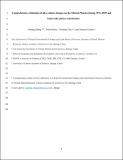Files in this item
Comprehensive estimation of lake volume changes on the Tibetan Plateau during 1976–2019 and basin-wide glacier contribution
Item metadata
| dc.contributor.author | Zhang, Guoqing | |
| dc.contributor.author | Bolch, Tobias | |
| dc.contributor.author | Chen, Wenfeng | |
| dc.contributor.author | Crétaux, Jean François | |
| dc.date.accessioned | 2022-01-30T00:42:31Z | |
| dc.date.available | 2022-01-30T00:42:31Z | |
| dc.date.issued | 2021-06-10 | |
| dc.identifier | 272952918 | |
| dc.identifier | bd6524ae-53a1-43b1-9f85-318a9ebe5652 | |
| dc.identifier | 85100518887 | |
| dc.identifier | 000628753700088 | |
| dc.identifier.citation | Zhang , G , Bolch , T , Chen , W & Crétaux , J F 2021 , ' Comprehensive estimation of lake volume changes on the Tibetan Plateau during 1976–2019 and basin-wide glacier contribution ' , Science of the Total Environment , vol. 772 , 145463 . https://doi.org/10.1016/j.scitotenv.2021.145463 | en |
| dc.identifier.issn | 0048-9697 | |
| dc.identifier.other | ORCID: /0000-0002-8201-5059/work/89178701 | |
| dc.identifier.uri | https://hdl.handle.net/10023/24776 | |
| dc.description | This study was supported by grants from the Natural Science Foundation of China (41831177 , 41871056), the European Space Agency within the Dragon 4 program ( 4000121469/17/I-NB), the Swiss National Science Foundation (No. 200021E_177652/1) within the framework of the DFG Research Unit GlobalCDA (FOR2630), and the French Space Agency (CNES ). G. Zhang wants to thank the China Scholarship Council for supporting his visit to University of Zurich (the former affiliation of T. Bolch) from December 2017 to December 2018. | en |
| dc.description.abstract | Volume changes and water balances of the lakes on the Tibetan Plateau (TP) are spatially heterogeneous and the lake-basin scale drivers remain unclear. In this study, we comprehensively estimated water volume changes for 1132 lakes larger than 1 km2 and determined the glacier contribution to lake volume change at basin-wide scale using satellite stereo and multispectral images. Overall, the water mass stored in the lakes increased by 169.7 ± 15.1 Gt (3.9 ± 0.4 Gt yr−1) between 1976 and 2019, mainly in the Inner-TP (157.6 ± 11.6 or 3.7 ± 0.3 Gt yr−1). A substantial increase in mass occurred between 1995 and 2019 (214.9 ± 12.7 Gt or 9.0 ± 0.5 Gt yr−1), following a period of decrease (−45.2 ± 8.2 Gt or −2.4 ± 0.4 Gt yr−1) prior to 1995. A slowdown in the rate of water mass increase occurred between 2010 and 2015 (23.1 ± 6.5 Gt or 4.6 ± 1.3 Gt yr−1), followed again by a high value between 2015 and 2019 (65.7 ± 6.7 Gt or 16.4 ± 1.7 Gt yr−1). The increased lake-water mass occurred predominately in glacier-fed lakes (127.1 ± 14.3 Gt) in contrast to non-glacier-fed lakes (42.6 ± 4.9 Gt), and in endorheic lakes (161.9 ± 14.0 Gt) against exorheic lakes (7.8 ± 5.8 Gt) over 1976–2019. Endorheic and glacier-fed lakes showed strongly contrasting patterns with a remarkable storage increase in the northern TP and slight decrease in the southern TP. The ratio of excess glacier meltwater runoff to lake volume increase between 2000 and ~2019 was less than 30% for the entire Inner-TP based on several independent data sets. Among individual lake-basins, 14 showed a glacier contribution to lake volume increase of 0.3% to 29.1%. The other eight basins exhibited a greater glacier contribution of 116% to 436%, which could be explained by decreased net precipitation. The lake volume change and basin scale glacier contribution reveal that the enhanced precipitation predominantly drives lake volume increase but it is spatially heterogeneous. | |
| dc.format.extent | 16 | |
| dc.format.extent | 3892942 | |
| dc.language.iso | eng | |
| dc.relation.ispartof | Science of the Total Environment | en |
| dc.subject | Glacier mass balance | en |
| dc.subject | Lake volume change | en |
| dc.subject | Lake water balance | en |
| dc.subject | Tibetan Plateau | en |
| dc.subject | GE Environmental Sciences | en |
| dc.subject | Environmental Engineering | en |
| dc.subject | Environmental Chemistry | en |
| dc.subject | Waste Management and Disposal | en |
| dc.subject | Pollution | en |
| dc.subject | 3rd-DAS | en |
| dc.subject.lcc | GE | en |
| dc.title | Comprehensive estimation of lake volume changes on the Tibetan Plateau during 1976–2019 and basin-wide glacier contribution | en |
| dc.type | Journal article | en |
| dc.contributor.institution | University of St Andrews. School of Geography & Sustainable Development | en |
| dc.contributor.institution | University of St Andrews. Bell-Edwards Geographic Data Institute | en |
| dc.contributor.institution | University of St Andrews. Environmental Change Research Group | en |
| dc.identifier.doi | 10.1016/j.scitotenv.2021.145463 | |
| dc.description.status | Peer reviewed | en |
| dc.date.embargoedUntil | 2022-01-30 |
This item appears in the following Collection(s)
Items in the St Andrews Research Repository are protected by copyright, with all rights reserved, unless otherwise indicated.

